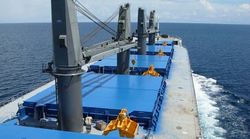Dry bulk options trading rises ahead of IMO 2020

Uncertainty over fuel costs come 2020 is spurring dry bulk participants to the derivatives market. While total Forward Freight Agreement volumes have declined by 3% between January and October, options have increased by 39% versus a year earlier.
UNCERTAINTY surrounding low-sulphur regulations being introduced from 2020 has forced dry bulk participants to turn to the options market.
Total dry options volumes rose 39% to 244,106 lots between January and October this year, from 176,004 over the same period a year earlier, according to data from the Baltic Exchange.
While capesizes dominated trading, it was the panamax segment that saw the biggest increase.
Volume in capes rose 28% to 162,535 lots, while panamaxes surged 72% to 78,157 lots. Supramax options were meanwhile up 7.4% to 3,414 lots.
One active market participant said it is mainly speculators who are taking positions for end-2019 and into 2020 ahead of the International Maritime Organization's 0.5% sulphur rule that comes into effect on January 1, 2020, which has led to the rise.
Capesizes and panamaxes, being the biggest bulk carriers, will consume more fuel than the other segments, making them the most risky in terms of anticipating fuel costs.
Besides IMO 2020, Freight Investor Services attributed the higher volumes to greater awareness by the wider commodity trading community about the existence of the Forward Freight Agreement options market and the ease of trading within it.
"More sophisticated funds and trading houses are utilising the options market, whereas in the past they were purely devoted to futures," the brokerage said.
It added that volume has been supported by "more complex multi-leg strategies, which typically inflate overall volume levels that trade in the market".
In addition, a very volatile underlying futures contract generates demand for options hedging strategies, the brokerage said.
According to Singapore Exchange's associate director of commodities derivatives Calum Austin, one can look at the capesize forward curve to assess where the market is pricing the sulphur change.
Volumes in the FFA market, however, declined 3% over the period to 972,269 lots, led by the capesize sector, which is more volatile than other segments.
Capesize volumes dropped 15% to 377,911 lots, while handysizes plummeted to 2,130 lots versus 7,000 a year earlier.
The drop in handysizes, the smallest vessel type, can be attributed to a change in the Baltic Dry Index calculation earlier in the year, which excluded the handysize sector as it was not a very liquid market.
Panamax FFAs meanwhile increased 8.3% to 470,235 lots, while supramax volumes were mildly up at 121,993 lots.
Separately, SGX will be launching a 65% iron ore futures contract in December as China increasingly prefers to trade the higher-grade product.